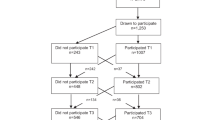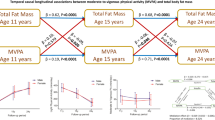Abstract
Background/Objectives
Children and adolescents spend a substantial amount of time being sedentary. The impact of prolonged sedentary patterns on fat distribution has not been elucidated especially in the context of physical activity level. Our objective is to examine the independent and joint associations of prolonged sedentary patterns and physical activity level with fat distribution among children and adolescents.
Subjects/Methods
This included US children (8–11 years) and adolescents (12–19 years) from the National Health and Nutrition Examination Survey 2003–2006. Sedentary patterns comprise accelerometer-measured average sedentary bout duration and self-reported time of sitting watching TV/videos. Fat distribution (trunk and total fat percentage) was determined via dual X-ray absorptiometry.
Results
Among 810 children and 2062 adolescents, average sedentary bout duration was associated with greater total and trunk fat percentages only among male children, after adjusting for moderate-to-vigorous physical activity (MVPA) level by accelerometer. Prolonged sitting watching TV/videos was associated with higher total and trunk fat percentages in male children and all adolescents, independent of levels of MVPA (all P for trend <0.05). Compared with ≤1 h/day, male children who spent ≥4 h/day sitting watching TV/videos had 4.43% higher trunk fat (95% CI, 1.69–7.17%), with similar associations for female (3.53%; 95% CI, 1.03–6.03%) and male adolescents (4.78%; 95% CI, 2.97–6.60%). About 13–17% children and adolescents spent <1 h on MVPA and ≥4 h sitting watching TV/videos per day. Compared with the most active group (MVPA ≥ 1 h/day and sitting watching TV/videos ≤1 h/day), trunk fat in this least active group was 6.21% higher in female children, 9.90% higher in male children, 6.84% higher in female adolescents, and 5.36% higher in male adolescents.
Conclusions
Prolonged time spent on sitting watching TV/videos was associated with fat accumulation among children and adolescents, independent of physical activity level.
This is a preview of subscription content, access via your institution
Access options
Subscribe to this journal
Receive 12 print issues and online access
$259.00 per year
only $21.58 per issue
Buy this article
- Purchase on Springer Link
- Instant access to full article PDF
Prices may be subject to local taxes which are calculated during checkout

Similar content being viewed by others
References
Bull FC, Al-Ansari SS, Biddle S, Borodulin K, Buman MP, Cardon G, et al. World Health Organization 2020 guidelines on physical activity and sedentary behaviour. Br J Sports Med. 2020;54:1451–62.
Katzmarzyk PT, Powell KE, Jakicic JM, Troiano RP, Piercy K, Tennant B, et al. Sedentary behavior and health: update from the 2018 Physical Activity Guidelines Advisory Committee. Med Sci Sports Exerc. 2019;51:1227–41.
Piercy KL, Troiano RP, Ballard RM, Carlson SA, Fulton JE, Galuska DA, et al. The physical activity guidelines for Americans. JAMA. 2018;320:2020–8.
Stamatakis E, Ekelund U, Ding D, Hamer M, Bauman AE, Lee IM. Is the time right for quantitative public health guidelines on sitting? A narrative review of sedentary behaviour research paradigms and findings. Br J Sports Med. 2019;53:377–82.
Yang L, Cao C, Kantor ED, Nguyen LH, Zheng X, Park Y, et al. Trends in sedentary behavior among the US population, 2001–2016. JAMA. 2019;321:1587–97.
Guthold R, Stevens GA, Riley LM, Bull FC. Global trends in insufficient physical activity among adolescents: a pooled analysis of 298 population-based surveys with 1.6 million participants. Lancet Child Adolesc Health. 2020;4:23–35.
Matthews CE, Chen KY, Freedson PS, Buchowski MS, Beech BM, Pate RR, et al. Amount of time spent in sedentary behaviors in the United States, 2003–2004. Am J Epidemiol. 2008;167:875–81.
Troiano RP, Berrigan D, Dodd KW, Masse LC, Tilert T, McDowell M. Physical activity in the United States measured by accelerometer. Med Sci Sports Exerc. 2008;40:181–8.
Gurnani M, Birken C, Hamilton J. Childhood obesity: causes, consequences, and management. Pediatr Clin North Am. 2015;62:821–40.
Steinberger J, Jacobs DR, Raatz S, Moran A, Hong CP, Sinaiko AR. Comparison of body fatness measurements by BMI and skinfolds vs dual energy X-ray absorptiometry and their relation to cardiovascular risk factors in adolescents. Int J Obes (Lond). 2005;29:1346–52.
Henderson M, Benedetti A, Barnett TA, Mathieu ME, Deladoey J, Gray-Donald K. Influence of adiposity, physical activity, fitness, and screen time on insulin dynamics over 2 years in children. JAMA Pediatr. 2016;170:227–35.
Cooper AR, Goodman A, Page AS, Sherar LB, Esliger DW, van Sluijs EM, et al. Objectively measured physical activity and sedentary time in youth: the International children’s accelerometry database (ICAD). Int J Behav Nutr Phys Act. 2015;12:113.
Loprinzi PD, Cardinal BJ, Lee H, Tudor-Locke C. Markers of adiposity among children and adolescents: implications of the isotemporal substitution paradigm with sedentary behavior and physical activity patterns. J Diabetes Metab Disord. 2015;14:46.
Gaba A, Pedisic Z, Stefelova N, Dygryn J, Hron K, Dumuid D, et al. Sedentary behavior patterns and adiposity in children: a study based on compositional data analysis. BMC Pediatr. 2020;20:147.
Janz KF, Levy SM, Burns TL, Torner JC, Willing MC, Warren JJ. Fatness, physical activity, and television viewing in children during the adiposity rebound period: the Iowa Bone Development Study. Prev Med. 2002;35:563–71.
Collings PJ, Brage S, Ridgway CL, Harvey NC, Godfrey KM, Inskip HM, et al. Physical activity intensity, sedentary time, and body composition in preschoolers. Am J Clin Nutr. 2013;97:1020–8.
Judice PB, Silva AM, Berria J, Petroski EL, Ekelund U, Sardinha LB. Sedentary patterns, physical activity and health-related physical fitness in youth: a cross-sectional study. Int J Behav Nutr Phys Act. 2017;14:25.
Broadney MM, Belcher BR, Berrigan DA, Brychta RJ, Tigner IL Jr, Shareef F, et al. Effects of interrupting sedentary behavior with short bouts of moderate physical activity on glucose tolerance in children with overweight and obesity: a randomized crossover trial. Diabetes Care. 2018;41:2220–8.
Sugiyama T, Healy GN, Dunstan DW, Salmon J, Owen N. Is television viewing time a marker of a broader pattern of sedentary behavior? Ann Behav Med. 2008;35:245–50.
Taylor RW, Grant AM, Williams SM, Goulding A. Sex differences in regional body fat distribution from pre- to postpuberty. Obesity (Silver Spring). 2010;18:1410–6.
Curtin LR, Mohadjer LK, Dohrmann SM, Montaquila JM, Kruszan-Moran D, Mirel LB, et al. The National Health and Nutrition Examination Survey: sample design, 1999–2006. Vital Health Stat. 2012;2:1–39.
Van Domelen DR, Pittard WS. Flexible R functions for processing accelerometer data, with emphasis on NHANES 2003–2006. R J. 2014;6:52–62.
National Cancer Institute. SAS programs for analyzing NHANES 2003–2004 accelerometer data. https://epi.grants.cancer.gov/nhanes-pam/.
Biddle SJ, Gorely T, Pearson N, Bull FC. An assessment of self-reported physical activity instruments in young people for population surveillance: Project ALPHA. Int J Behav Nutr Phys Act. 2011;8:1.
Guenther PM, Kirkpatrick SI, Reedy J, Krebs-Smith SM, Buckman DW, Dodd KW, et al. The Healthy Eating Index-2010 is a valid and reliable measure of diet quality according to the 2010 Dietary Guidelines for Americans. J Nutr. 2014;144:399–407.
Johnson CL, Paulose-Ram R, Ogden CL, Carroll MD, Kruszon-Moran D, Dohrmann SM, et al. National health and nutrition examination survey: analytic guidelines, 1999–2010. Vital Health Stat 2. 2013:1–24.
Karlsson AK, Kullberg J, Stokland E, Allvin K, Gronowitz E, Svensson PA, et al. Measurements of total and regional body composition in preschool children: a comparison of MRI, DXA, and anthropometric data. Obesity (Silver Spring). 2013;21:1018–24.
Saunders TJ, Tremblay MS, Mathieu ME, Henderson M, O’Loughlin J, Tremblay A, et al. Associations of sedentary behavior, sedentary bouts and breaks in sedentary time with cardiometabolic risk in children with a family history of obesity. PLoS One. 2013;8:e79143.
Gu X, Tucker KL. Dietary quality of the US child and adolescent population: trends from 1999 to 2012 and associations with the use of federal nutrition assistance programs. Am J Clin Nutr. 2017;105:194–202.
American Academy of Pediatrics. Committee on Public EducationAmerican Academy of Pediatrics: children, adolescents, and television. Pediatrics.2001;107:423–6.
Fang K, Mu M, Liu K, He Y. Screen time and childhood overweight/obesity: a systematic review and meta-analysis. Child Care Health Dev. 2019;45:744–53.
Tikkanen O, Haakana P, Pesola AJ, Hakkinen K, Rantalainen T, Havu M, et al. Muscle activity and inactivity periods during normal daily life. PLoS One. 2013;8:e52228.
Dunstan DW, Kingwell BA, Larsen R, Healy GN, Cerin E, Hamilton MT, et al. Breaking up prolonged sitting reduces postprandial glucose and insulin responses. Diabetes Care. 2012;35:976–83.
Swartz AM, Squires L, Strath SJ. Energy expenditure of interruptions to sedentary behavior. Int J Behav Nutr Phys Act. 2011;8:69.
Robinson TN, Banda JA, Hale L, Lu AS, Fleming-Milici F, Calvert SL, et al. Screen media exposure and obesity in children and adolescents. Pediatrics. 2017;140:S97–S101.
Mazess RB, Barden HS, Bisek JP, Hanson J. Dual-energy x-ray absorptiometry for total-body and regional bone-mineral and soft-tissue composition. Am J Clin Nutr. 1990;51:1106–12.
Funding
This research was in part supported by U.S. National Institutes of Health (NIH) grant P30CA091842. JL was supported by the China Scholarship Council. JC was supported by T32 CA190194. ES is funded by a National Health and Medicine Research Council (NHMRC, Australia) through a Senior Research Fellowship (grant code: APP1110526), and a Leadership 2 fellowship (code: APP1180812). The funders had no role in design and conduct of the study; collection, management, analysis, and interpretation of the data; and preparation, review, or approval of the manuscript.
Author information
Authors and Affiliations
Contributions
JL, CC, and YC had full access to all the data in the study and take responsibility for the integrity of the data and the accuracy of the data analysis. Study concept and design: JL, CC, YC. Acquisition, analysis, or interpretation of data: all coauthors. Drafting of the manuscript: JL, CC, YC. Critical revision of the manuscript for important intellectual content: all authors. Statistical analysis: JL, CC. Administrative, technical, or material support: YC. Study supervision: YC.
Corresponding author
Ethics declarations
Conflict of interest
The authors declare no competing interests.
Additional information
Publisher’s note Springer Nature remains neutral with regard to jurisdictional claims in published maps and institutional affiliations.
Supplementary information
Rights and permissions
About this article
Cite this article
Liao, J., Cao, C., Hur, J. et al. Association of sedentary patterns with body fat distribution among US children and adolescents: a population-based study. Int J Obes 45, 2048–2057 (2021). https://doi.org/10.1038/s41366-021-00874-7
Received:
Revised:
Accepted:
Published:
Issue Date:
DOI: https://doi.org/10.1038/s41366-021-00874-7
This article is cited by
-
Serum Iron Levels, Dietary Iron Intake, and Supplement Use in Relation to Metabolic Syndrome in Adolescents: A Cross-Sectional Study
Biological Trace Element Research (2024)
-
Dietary inflammatory index and metabolic syndrome in US children and adolescents: evidence from NHANES 2001–2018
Nutrition & Metabolism (2022)
-
Interaction between trouble sleeping and depression on hypertension in the NHANES 2005–2018
BMC Public Health (2022)
-
A randomised controlled trial investigating the ability for supervised exercise to reduce treatment-related decline in adolescent and young adult cancer patients
Supportive Care in Cancer (2022)



